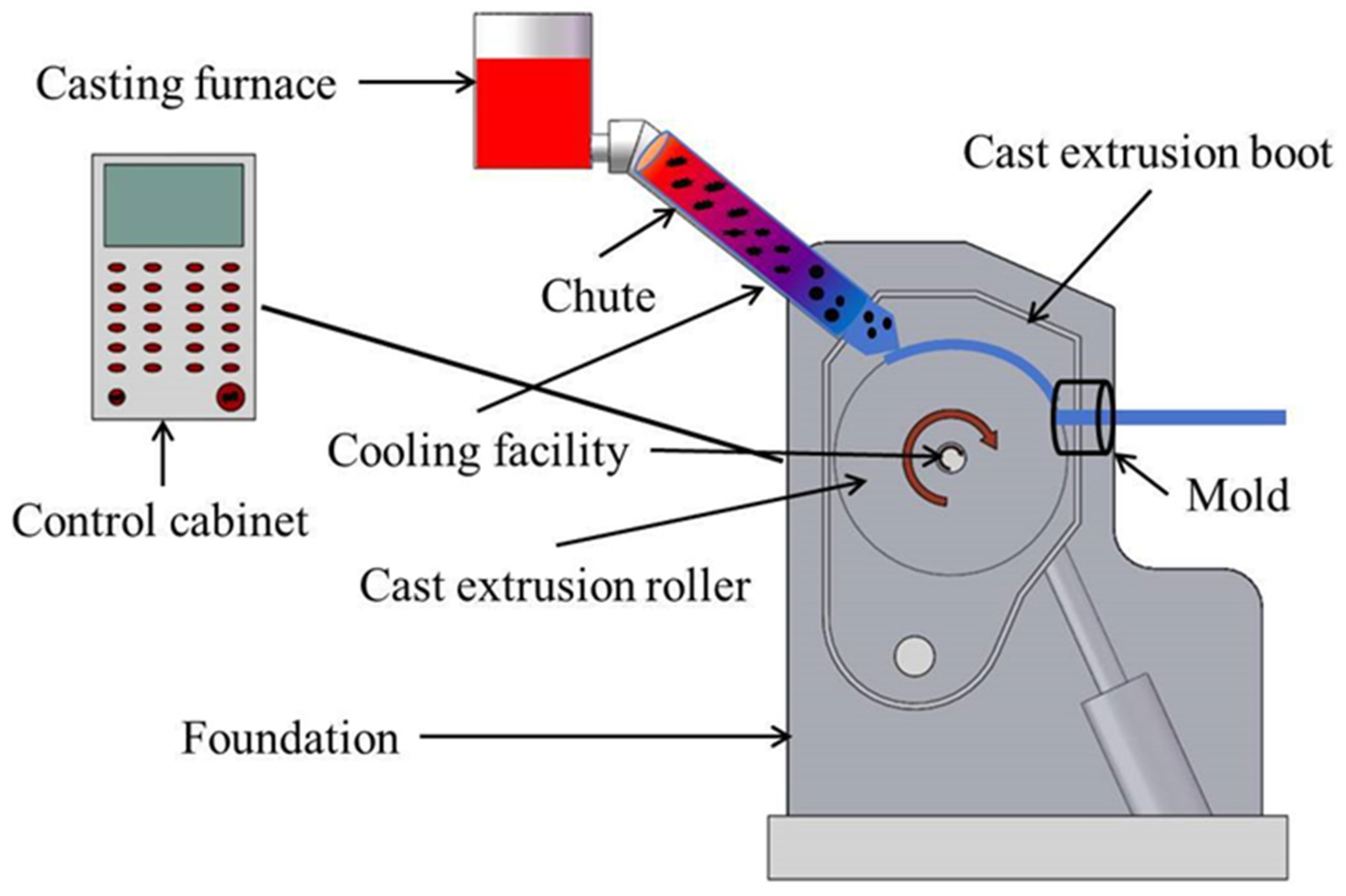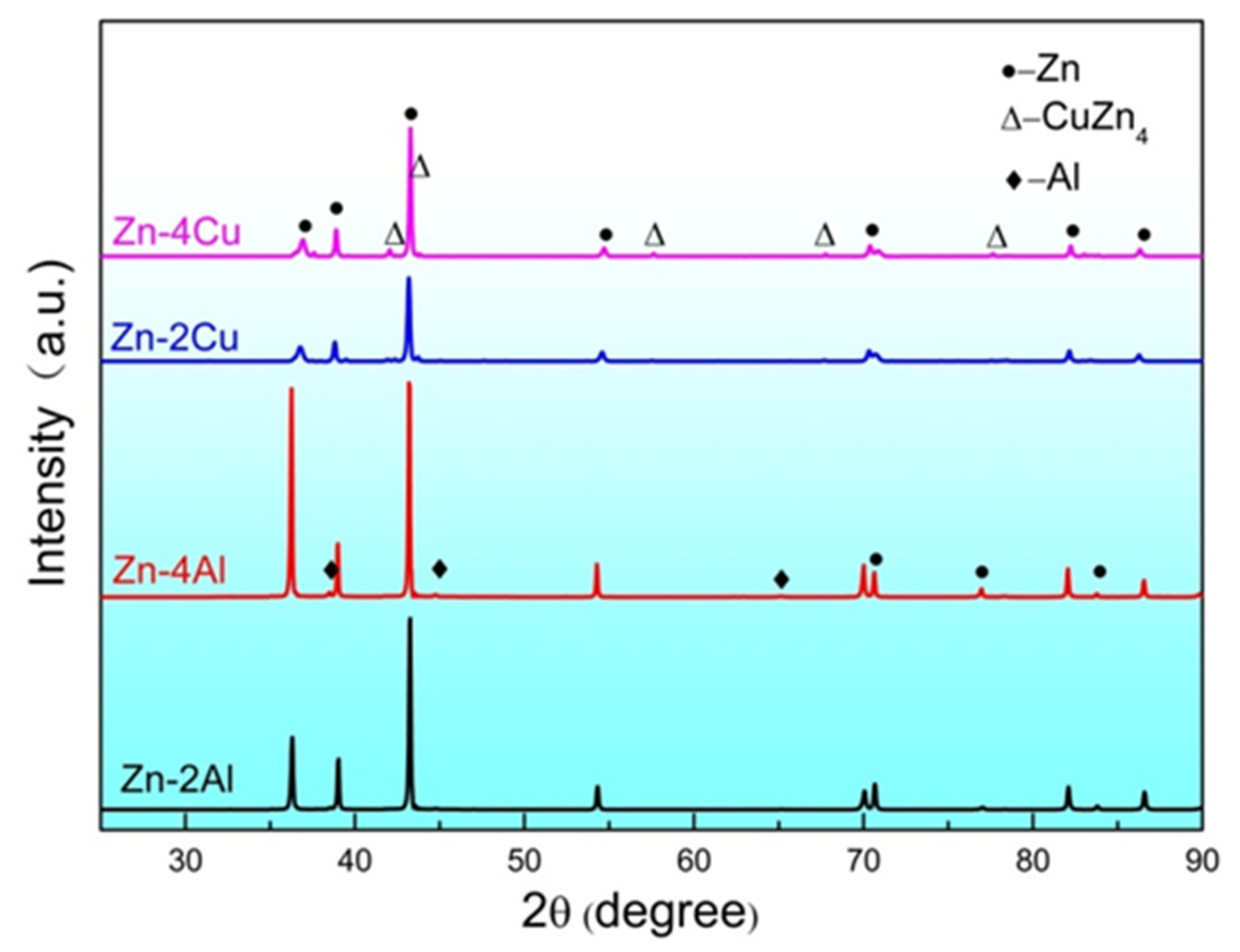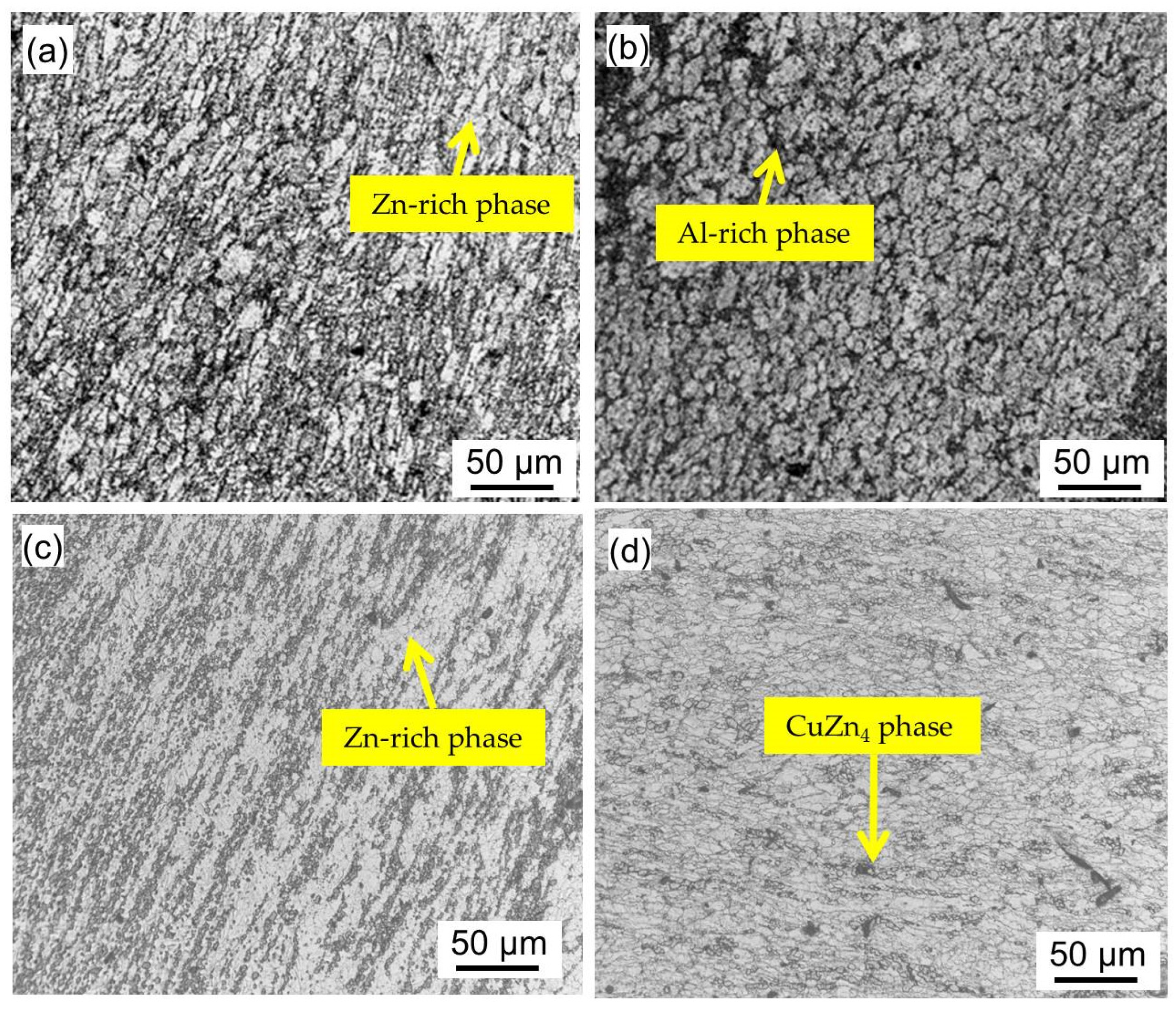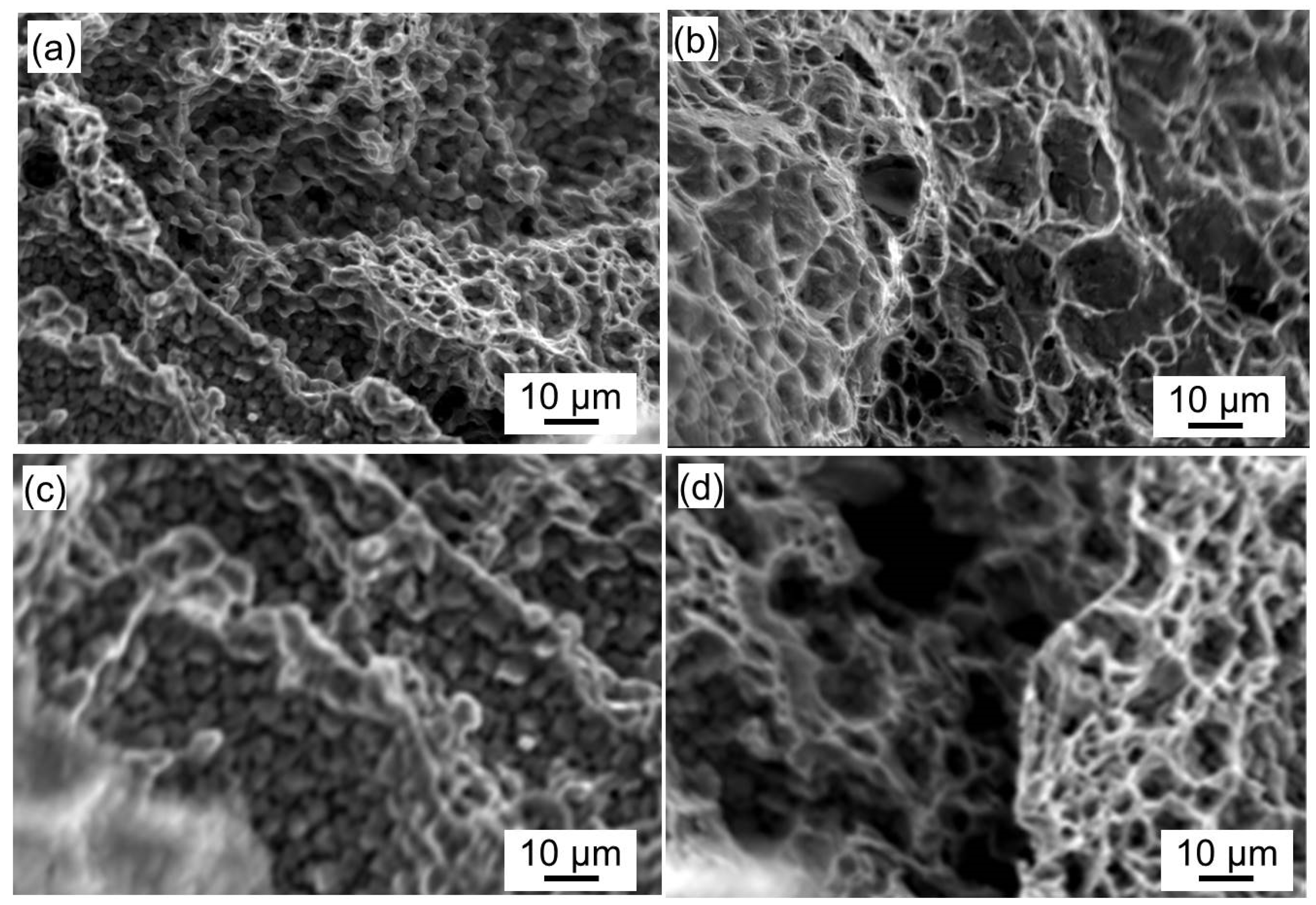Effect of Al or Cu Content on Microstructure and Mechanical Properties of Zn Alloys Fabricated Using Continuous Casting and Extrusion
Abstract
:1. Introduction
2. Materials and Methods
3. Results and Discussion
3.1. X-ray Diffraction
3.2. Microstructure
3.3. Mechanical Properties
4. Conclusions
- (1)
- The Zn alloy with a lower Al or Cu contents can be prepared by continuous casting and extrusion.
- (2)
- With the increase in Al content, the strength of the Zn-Al alloy slightly decreases, and the elongation of the Zn-Al alloy significantly increases from 1.2% to 20%, which is due to matrix refinement and the presence of lamellar eutectic.
- (3)
- Cu has a weak effect on enhancing the mechanical properties of Zn alloys compared to Al. This is attributed to the size and content of the second phase and refines the microstructure of the Zn alloy.
Author Contributions
Funding
Data Availability Statement
Acknowledgments
Conflicts of Interest
References
- Sun, S.N.; Ren, Y.P.; Wang, L.Q.; Yang, B.; Qin, G.W. Room temperature quasi-superplasticity behavior of backward extruded Zn-15Al alloys. Mater. Sci. Eng. A 2016, 676, 336–341. [Google Scholar] [CrossRef]
- Kustra, P.; Wróbel, M.; Byrska-Wójcik, D.; Paćko, M.; Płonka, B.; Wróbel, M.; Sulej-Chojnacka, J.; Milenin, A. Manufacture technology, mechanical and biocorrosion properties of the Zn and ZnMg0.008 alloy wires designed for biodegradable surgical threads. J. Manuf. Process. 2021, 67, 513–520. [Google Scholar] [CrossRef]
- Zhang, J.J.; Wang, Q.Z.; Jiao, Z.X.; Cui, C.X.; Yin, F.X.; Yao, C. Effects of combined use of inoculation and modification heat treatment on microstructure, damping and mechanical properties of Zn–Al eutectoid alloy. Mater. Sci. Eng. A 2020, 790, 139740. [Google Scholar] [CrossRef]
- Sun, S.N.; Wang, H.L.; Yang, B.; Qin, G.W. Effect of extrusion temperature on mechanical properties of as-extruded Zn–22Al alloys. Mater. Sci. Tech. 2020, 36, 805–810. [Google Scholar] [CrossRef]
- Ling, C.; Zhang, J.C. Strain rate and anisotropic effects on incipient plastic deformation of Zn–Cu–Ti alloy sheets. Mater. Sci. Eng. A 2024, 890, 145909. [Google Scholar]
- Azad, B.; Eivani, A.R.; Salehi, M.T. An investigation of microstructure and mechanical properties of as-cast Zn–22Al alloy during homogenizing and equal channel angular pressing. J. Mater. Res. Technol. 2023, 22, 3255–3269. [Google Scholar] [CrossRef]
- Zhang, J.D.; Zhu, X.L.; Guo, P.S.; Zhang, Y.D.; Xu, Y.; Pang, Y.; Song, Z.L.; Yang, L.J. Effects of Li addition on the properties of biodegradable Zn–Fe–Li alloy: Microstructure, mechanical properties, corrosion behavior, and cytocompatibility. Mater. Today Commun. 2024, 39, 108661. [Google Scholar] [CrossRef]
- Li, L.; Liang, W.L.; Ban, C.Y.; Suo, Y.S.; Lv, G.C.; Liu, T.; Wang, X.J.; Zhang, H.; Cui, J.Z. Effects of a high-voltage pulsed magnetic field on the solidification structures of biodegradable Zn-Ag alloys. Mater. Char. 2020, 163, 110274. [Google Scholar] [CrossRef]
- Shi, Z.Z.; Li, H.Y.; Xu, J.Y.; Gao, X.X.; Liu, X.F. Microstructure evolution of a high-strength low-alloy Zn-Mn-Ca alloy through casting, hot extrusion and warm caliber rolling. Mater. Sci. Eng. A 2020, 771, 138626. [Google Scholar] [CrossRef]
- Jin, H.L.; Yang, L.; Lai, Y.L.; Liu, Y. The effects of Zr content and hot rolling on the microstructure and mechanical properties of Zn-1.5Cu-1.0Ag-xZr alloys. J. Alloys Compd. 2022, 912, 165116. [Google Scholar] [CrossRef]
- Yang, Z.; Tang, J.; Mo, X.D.; Chen, W.T.; Fu, D.F.; Zhang, H.; Teng, J.; Jiang, F.L. Microstructure, mechanical properties, and strengthening mechanisms of ultra-high strength Al-Zn-Mg-Cu alloy prepared by continuous extrusion forming process. Mater. Des. 2024, 242, 112985. [Google Scholar] [CrossRef]
- Yang, B.W.; Gao, M.Q.; Liu, Y.; Pan, S.; Meng, S.C.; Fu, Y.; Guan, R.G. Formation mechanism of refined Al6(Mn, Fe) phase particles during continuous rheo-extrusion and its contribution to tensile properties in Al-Mg-Mn-Fe alloys. Mater. Sci. Eng. A 2023, 872, 144952. [Google Scholar] [CrossRef]
- Cao, F.R.; Yin, B.; Liu, S.Y.; Shi, L.; Wang, S.C.; Wen, J.L. Microstructural evolution, flow stress and constitutive modeling of Al-1.88Mg-0.18Sc-0.084Er alloy during hot compression. Trans. Nonferrous. Met. Soc. China 2021, 31, 53–73. [Google Scholar] [CrossRef]
- Zhao, D.J.; Qin, J.; Lü, S.L.; Li, J.Y.; Guo, W.; Wu, S.S.; Zhang, Y.H. Mechanisms of extrusion-ratio dependent ultrafine-grain fabrication in AZ31 magnesium alloy by continuous squeeze casting-extrusion. J. Mater. Process Tech. 2022, 310, 117755. [Google Scholar] [CrossRef]
- Sun, S.N.; Li, D.Y.; Liu, D.Y.; Yang, B.; Ren, Y.P.; Qin, G.W. Microstructure and mechanical properties of continuous casting and extrusion Zn-15 wt% Al alloys. Mater. Lett. 2020, 261, 127090. [Google Scholar] [CrossRef]
- Sun, S.N.; Li, D.Y.; Liu, D.Y.; Yang, B.; Ren, Y.P.; Liu, J.T.; Xie, H.B. Effects of Bi and Ce addition on tensile properties and corrosion resistance of Zn-15Al alloys by continuous casting and extrusion. Mater. Lett. 2020, 275, 128027. [Google Scholar] [CrossRef]
- Ye, L.F.; Sun, C.; Zhuo, X.R.; Liu, H.; Ju, J.; Xue, F.; Bai, J.; Jiang, J.H.; Xin, Y.C. Evolution of grain size and texture of Zn-0.5Cu ECAP alloy during annealing at 200 °C and its impact on mechanical properties. J. Alloys Compd. 2022, 919, 165871. [Google Scholar] [CrossRef]
- Liu, C.; Li, Y.K.; Ge, Q.Q.; Liu, Z.X.; Qiao, A.K.; Mu, Y.L. Mechanical characteristics and in vitro degradation of biodegradable Zn-Al alloy. Mater. Lett. 2021, 300, 130181. [Google Scholar] [CrossRef]
- Yang, H.T.; Jia, B.; Zhang, Z.C.; Qu, X.H.; Li, G.N.; Lin, W.J.; Zhu, D.H.; Dai, K.R.; Zheng, Y.F. Alloying design of biodegradable zinc as promising bone implants for load-bearing applications. Nat. Commun. 2020, 11, 401. [Google Scholar] [CrossRef]
- Lu, X.K.; Xiao, S.J.; He, W.Q.; Wang, J.J.; Ma, Y.M.; Zhang, H.H. Effect of melt overheating treatment on the microstructure and mechanical properties of Zn–Al alloy. Vacuum 2022, 201, 111071. [Google Scholar] [CrossRef]
- Cao, F.R.; Wen, J.L.; Ding, H.; Wang, Z.D.; Yu, C.P.; Xia, F. Extrusion force analysis of aluminum pipe fabricated by CASTEX using expansion combination die. Trans. Nonferrous Met. Soc. China 2014, 24, 3621–3631. [Google Scholar] [CrossRef]
- ASTME8-04; Test Methods for Tension Testing of Metallic Materials. American Society for Testing and Materials: West Conshohocken, PN, USA, 2004.
- Song, Z.Z.; Niu, R.M.; Cui, X.Y.; Bobruk, E.V.; Murashkin, M.Y.; Enikeev, N.A.; Gu, J.; Song, M.; Bhatia, V.; Ringer, S.P.; et al. Mechanism of room-temperature superplasticity in ultrafine-grained Al-Zn alloys. Acta Mater. 2023, 246, 118671. [Google Scholar] [CrossRef]
- Zhai, Y.L.; Wang, T.G.; Liu, M.Y.; Zhou, N.; Li, X.T. Effect of Al Content on the microstructure and Properties of Zn-Al Solder Alloys. Metals 2024, 14, 689. [Google Scholar] [CrossRef]
- Jiang, J.M.; Huang, H.; Niu, J.L.; Jin, Z.H.; Dargusch, M.; Yuan, G.Y. Characterization of nano precipitate phase in an as-extruded Zn-Cu alloy. Scr. Mater. 2021, 200, 113907. [Google Scholar] [CrossRef]
- Jara-Cháves, G.; Amaro-Villeda, A.; Campillo-Illanes, B.; Ramírez-Argáez, M.; González-Rivera, C. Effect of Ag and Cu Content on the Properties of Zn-Ag-Cu-0.05Mg Alloys. Metals 2024, 14, 740. [Google Scholar] [CrossRef]
- Gutierrez-Menchaca, J.; Torres-Torres, D.; Garay-Tapia, A.M. Microstructural, mechanical and thermodynamic study of the as-cast Zn-Al-Sr alloys at high Sr content. J. Alloys Compd. 2020, 829, 154511. [Google Scholar] [CrossRef]
- Sun, S.N.; Liu, J.T.; Li, X.L.; Ye, G.; Weng, Y.M.; Lu, Z.T.; Lou, D.F. High ductility Zn-6Al alloys with fine-grained microstructure processed by low temperature backward extrusion. Rare Metal. Mat. Eng. 2021, 50, 2263–2267. [Google Scholar]
- Farabi, E.; Sharp, J.A.; Valid, A.; Fabijanic, D.M.; Barnett, M.R.; Gallo, S.C. Development of high strength and ductile Zn-Al-Li alloys for potential use in bioresorbable medical devices. Mater. Sci. Eng. C 2021, 122, 111897. [Google Scholar] [CrossRef] [PubMed]
- Wu, Z.C.; Sandlobes, S.; Wu, L.; Hu, W.P.; Gottstein, G.; Korte-kerzel, S. Mechanical behaviour of Zn-Al-Cu-Mg alloys: Deformation mechanisms of as-cast microstructures. Mater. Sci. Eng. A 2016, 651, 675–687. [Google Scholar] [CrossRef]
- Demirtas, M.; Kawasaki, M.; Yanar, H.; Purcek, G. High temperature superplasticity and deformation behavior of naturally aged Zn-Al alloys with different phase compositions. Mater. Sci. Eng. A 2018, 730, 73–83. [Google Scholar] [CrossRef]
- Sun, S.N.; Ren, Y.P.; Wang, L.Q.; Yang, B.; Li, H.X.; Qin, G.W. Abnormal effect of Mn addition on the mechanical properties of as-extruded Zn alloys. Mater. Sci. Eng. A 2017, 701, 129–133. [Google Scholar] [CrossRef]
- Tang, Z.B.; Niu, J.L.; Huang, H.; Zhang, H.; Pei, J.; Ou, J.M.; Yuan, G.Y. Potential biodegradable Zn-Cu binary alloys developed for cardiovascular implant applications. J. Mech. Behav. Biomed. 2017, 72, 182–191. [Google Scholar] [CrossRef]
- Li, L.; Liang, W.L.; Yang, L.; Cao, F.L.; Sun, K.; Ban, C.Y.; Cui, J.Z. Structure refinement and homogenization of Zn-Cu alloys induced by a high-voltage pulsed magnetic field during the solidification process. Int. J. Metal. Cast. 2023, 17, 399–413. [Google Scholar] [CrossRef]
- Shi, Z.Z.; Gao, X.X.; Zhang, H.J.; Liu, X.F.; Li, H.Y.; Zhou, C.; Yin, Y.X.; Wang, L.N. Design biodegradable Zn alloys: Second phases and their significant influences on alloy properties. Bioact. Mater. 2020, 5, 210–218. [Google Scholar] [CrossRef] [PubMed]
- Bolibruchová, D.; Bruna, M.; Matejka, M. Impact of Remelting on ZnAl4Cu3 Alloy with Addition of Cd on Selected Technological and Mechanical Properties. Metals 2022, 12, 1180. [Google Scholar] [CrossRef]
- Yang, H.; Huang, J.; Chen, S.; Zhao, X.; Wang, Q.; Li, D. Influence of the composition of Zn-Al filler metal on the interfacial structure and property of Cu/Zn-Al/Al brazed joint. J. Acta Metall. Sin. 2015, 51, 364–370. [Google Scholar]







| Name | Al | Cu | Zn |
|---|---|---|---|
| Zn-2Al | 2 | 0 | Bal. |
| Zn-4Al | 4 | 0 | Bal. |
| Zn-2Cu | 0 | 2 | Bal. |
| Zn-4Cu | 0 | 4 | Bal. |
| Name | Al | Cu | Zn |
|---|---|---|---|
| 1 | 0.35 | 0 | Bal. |
| 2 | 22.46 | 0 | Bal. |
| 3 | 18.95 | 0 | Bal. |
| 4 | 0 | 1.72 | Bal. |
| 5 | 0 | 4.04 | Bal. |
Disclaimer/Publisher’s Note: The statements, opinions and data contained in all publications are solely those of the individual author(s) and contributor(s) and not of MDPI and/or the editor(s). MDPI and/or the editor(s) disclaim responsibility for any injury to people or property resulting from any ideas, methods, instructions or products referred to in the content. |
© 2024 by the authors. Licensee MDPI, Basel, Switzerland. This article is an open access article distributed under the terms and conditions of the Creative Commons Attribution (CC BY) license (https://creativecommons.org/licenses/by/4.0/).
Share and Cite
Sun, S.; Yu, J.; Wang, C. Effect of Al or Cu Content on Microstructure and Mechanical Properties of Zn Alloys Fabricated Using Continuous Casting and Extrusion. Metals 2024, 14, 888. https://doi.org/10.3390/met14080888
Sun S, Yu J, Wang C. Effect of Al or Cu Content on Microstructure and Mechanical Properties of Zn Alloys Fabricated Using Continuous Casting and Extrusion. Metals. 2024; 14(8):888. https://doi.org/10.3390/met14080888
Chicago/Turabian StyleSun, Shineng, Jie Yu, and Chao Wang. 2024. "Effect of Al or Cu Content on Microstructure and Mechanical Properties of Zn Alloys Fabricated Using Continuous Casting and Extrusion" Metals 14, no. 8: 888. https://doi.org/10.3390/met14080888





